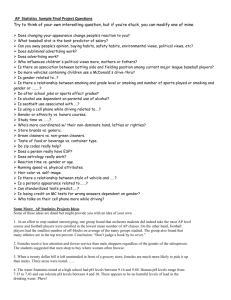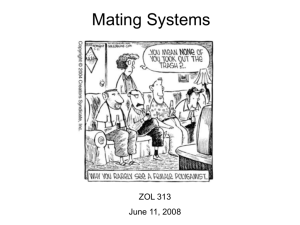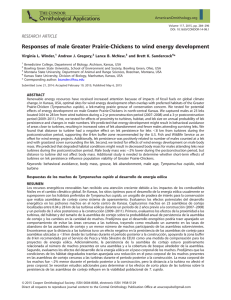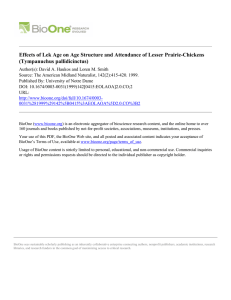Monogamy in Mammals
advertisement
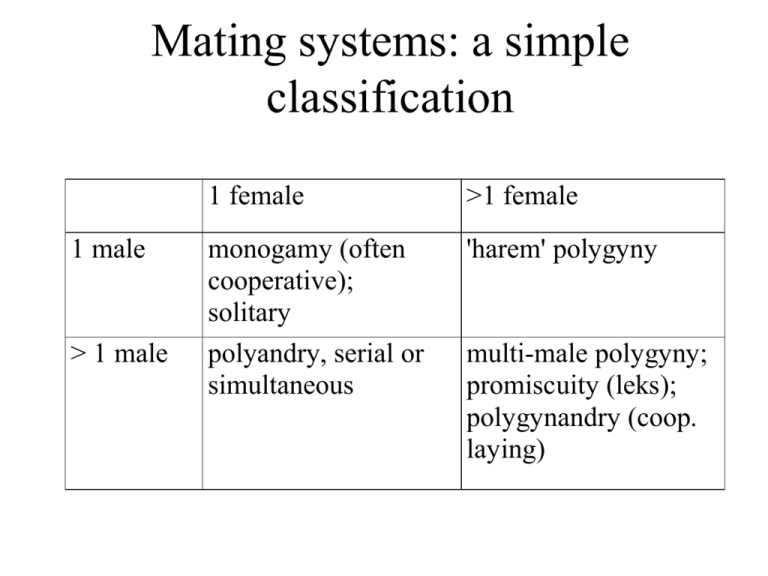
Mating systems: a simple classification 1 male > 1 male 1 female >1 female monogamy (often cooperative); solitary polyandry, serial or simultaneous 'harem' polygyny multi-male polygyny; promiscuity (leks); polygynandry (coop. laying) Monogamy in Mammals • Monogamy is rare in mammals • Why? Females put in most of the parental investment • Exception: when male parental care can make a difference • Enforcement: – Mate assistance – Female-enforced monogamy Monogamy in Birds • In birds, about 90% of species display monogamy • Why? Because in many cases, males can be effective parents (mate assistance) – Male advantage: caring for one clutch gives him higher success than deserting – Female advantage: male care improves her young’s chances of surviving Social vs. Genetic mating systems: Extra-Pair Copulations (EPC’s) • Even “monogamous” birds may mate with other individuals -- in fact, many do • Benefits to male: increased reproductive success • Costs to male: time and energy to search for other mates, possibility that female might also engage in EPC Why would females engage in EPC? • • • • • • Better sperm Good genes Different genes Material benefits Access to territories Male parental care Polyandry • Each male only mates with one female, but a female will mate with multiple males • Rare, but it happens • Sex role reversal polyandry occurs when females can easily lay more eggs, but at least one parent is needed to raise clutch • examples: Spotted sandpipers, jacanas Polyandry II • Polyandry can occur when more than 2 parents are needed to raise clutch or litter • Example: Saddle-backed tamarins. Multiple large offspring that grow quickly. Normally cooperative breeders, w/ prior offspring. For a new group, there are no existing offspring. Then, a male will tolerate or even invite another male to join group, mate with female and help to raise the offspring. Once the offspring are established, however, one of the males gets kicked out. Polygyny • Each female mates with only one male, but a male with mate with multiple females • Female defense (harem) polygyny. Females occur in groups (Why? We’ll see later) • Resource defense polygyny. Resources critical to female RS must be clustered or otherwise easy to defend. Some females would rather be a second female on a good territory than a monogamous female on a mediocre territory. Polygyny continued • Scramble competition polygyny. When all else fails…. If neither resources nor females are defendible, and females are not predictable, then just search for females as fast as possible. • Lek polygyny. Neither females nor resources are defendable, but females are predictable: – Hotspot model: predictable in space – Hotshot model: predictable preference for male – Cluster model: prefer males in clusters Predictions of Lek Models • Hot-spot model – 1. If remove males from lek, new males should move into the same area – 2. Males in all leks should have the same average reproductive success – 3. Female ranges should not change when males are removed • Hotshot model – 1. If move alpha male to a nearby location, the lek should follow – 2. If remove alpha male the lek will disperse Predictions of lek models (cont.) • Female preference – 1. Females disproportionately choose larger leks – 2. Females prefer “safe” spots for lek formation – 3. Females may prefer prominent locations Polygamy • Extra-pair copulations, although individuals may still have one “main” mate • Sequential polygamy – Females may deposit eggs in nests of several males and males may accept eggs from multiple females. At any one time, male is ‘mated’ with only one female. Ex: many fish • Polygynandry (Ex: rheas, tinamous) – Females move about in groups, laying eggs in one male’s nest at a time. Male is ‘polygynous’.




